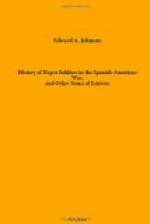FIELD AND STAFF OFFICERS.
Colonel.—Henry B. Freeman, under orders to join.
Lieutenant-Colonel.—Emerson H. Liscum, Brig.-Gen. Vols. On sick leave from wounds received in action at Fort San Juan, Cuba, July 1, 1898.
Majors.—J. Milton Thompson, commanding regiment and post of Fort Douglas, Utah. Alfred C. Markley, with regiment, commanding post of Fort D.A. Russell, Wyoming.
Chaplain.—Allen Allenworth, Post Treasurer and in charge of schools.
Adjutant.—Joseph D. Leitch, recruiting officer at post.
Quartermaster.—Albert Laws.
On July 1, 1898, our regiment was not a part of the firing line, and was not ordered on that line until the fire got so hot that the white troops positively refused to go forward. When our commander, Lieutenant-Colonel E.H. Liscum, was ordered to go in he gave the command “forward, march,” and we moved forward singing “Hold the Fort, for we are coming,” and on the eastern bank of the San Juan river we walked over the Seventy-first New York Volunteer Infantry. After wading the river we marched through the ranks of the Thirteenth (regular) Infantry and formed about fifty yards in their front. We were then about six hundred yards from and in plain view of the block-house and Spanish trenches. As soon as the Spaniards saw this they concentrated all of their fire on us, and, while changing from column to line of battle (which took about eight minutes).
Illustration: A large size photo of above picture can be had on application to P.H. Bauer, Photographer, Leavenworth, Kansas. we lost one hundred and two men, and that place on the river to-day is called “bloody bend.” We had only one advantage of the enemy-that was our superior marksmanship. I was right of the battalion that led the charge and I directed my line against the center of the trench, which was on a precipice about two hundred feet high.
Illustration: A large size photo of above picture can be had on application to P.H. Bauer, Photographer, Leavenworth, Kansas.
I was born December 4, 1852, in Wythe county, Virginia, and joined the army in Cincinnati, Ohio, November 22,1869, and have been in the army continuously since. I served my first ten years in the Tenth Cavalry, where I experienced many hard fights with the Indians. I was assigned to the Twenty-fourth Infantry by request in 1880.
E.D. GIBSON,
Sergeant Co. G, 24th U.S. Infantry,




